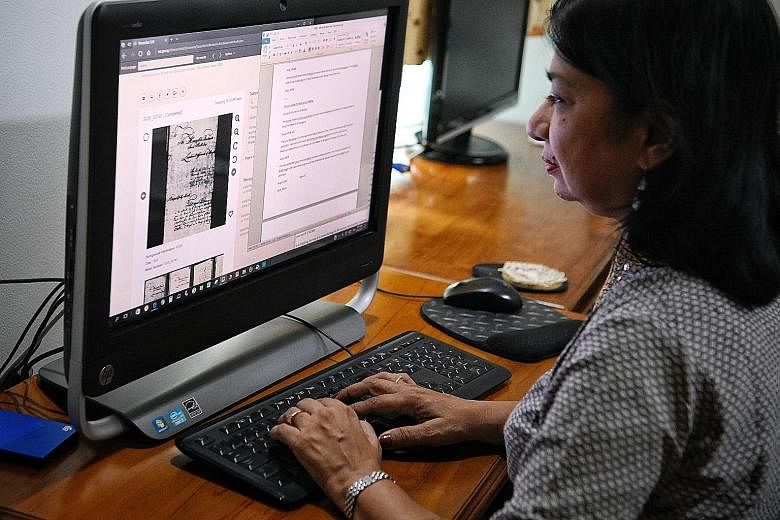Freelance writer Vandana Aggarwal, 55, has been on a two-year quest to piece together the details of the life of a convict-turned-philanthropist who lived in 19th-century Singapore.
And it all began with an effort to transcribe scanned images of Straits Settlements Records which had been uploaded online.
Kunnuck Mistree was convicted of larceny and in 1818, sent from India to British Bencoolen - now Bengkulu, Sumatra - where he worked as a dresser at a hospital. In 1825, he was sent to Singapore, where he again worked as a dresser at the convict hospital.
Sifting through the papers, Mrs Aggarwal found he had left a trail of letters from people he worked with vouching for his good conduct.
In 1846, he was granted a ticket of leave allowing him to live anywhere in Singapore and practise any profession. He specialised in traditional Indian medicine and bought property here, Mrs Aggarwal said. In 1855, he applied to the governor-general in India for a pardon, making an appeal to be allowed to return to India to die on the banks of the Ganges.
He donated land in Singapore for religious purposes and $1,100 for a bathing place, the latter earning him a mention in the 1859 Government Gazette. Even though his appeal was granted, he died in Singapore in 1865, leaving behind an estate worth $50,000 to his sons.
"His is an inspiring journey of a convict turning his life around, surmounting challenges, making the most of every opportunity and being successful. A true pioneer immigrant," said Mrs Aggarwal, who has transcribed nearly 7,000 pages of documents.
-
From the letters
The letters and documents examined provide an insight into the early days of the gardens in Singapore.
Some letters referred to Raffles' vision of a "Botanical and Experimental Garden" which was eventually established at Fort Canning in 1822, and closed in 1829.
In one letter, William Farquhar, then Resident of the island, instructed Lieutenant Philip Jackson, an assistant engineer, to construct "a proper railing or fence" around the Botanic and Experimental Garden "without delay".
In 1859, a letter from the Governor of the Straits Settlements granted the transfer of two lots of swamp land at Tanglin to the Botanical Garden Committee to convert into a public garden.
In 1858, a letter from the Commissioner of Police Singapore to the Secretary to the Governor of the Straits Settlements Singapore appealed for a Chinese man to be given a reward for having captured two tiger cubs with the help of tiger pits in the Bukit Timah neighbourhood.
Plans to end Singapore's status as a penal Settlement were discussed in 1860.
None of this might have been unearthed if not for the Citizen Archivist Project, which began in 2015 and invites the public to transcribe historical documents and oral interviews, and describe photographs. As of last week, 436 volunteers have transcribed more than 24,000 pages and 1,800 photos all together.
The documents are accessed online. Volunteers can transcribe Straits Settlements Records, the Field Notebooks of botanist C. E. Carr, and Lyrics From Yesteryear: 1920s-1970s. The National Archives of Singapore recently uploaded 47 volumes, or 16,394 pages, of the Straits Settlements Records. These mainly relate to Sir Thomas Stamford Raffles and date back to the early 19th century.
By next month, the public can transcribe and translate music record labels. These records are in Vietnamese, Khmer, Thai and Burmese. They trace the development of Singapore as an important regional centre for recording music from the 1900s to the early 1980s.
Mrs Aggarwal's obsession with Kunnuck Mistree has landed her a small place in the footnotes of history. An article she wrote for the National Archives of Singapore was cited last year in the master's thesis of someone from a university in the Netherlands.
She does extra research to find out more about the context of each document. Once, she sent a script she thought was written in Urdu to five people in India, before an Arabic teacher in Singapore pointed out it was Jawi and helped her translate it into English.
Volunteer Daisy Fong, 55, said: "I thought the (Straits Settlements Records) would be about war, pirates, convict rebellions, but no. They talk about regular things like sick leave."
Poring over the old documents, the finance professional learnt that Penang used to be called Prince of Wales Island, and Tan Tock Seng Hospital was known as the Chinese Pauper Hospital.
Old writings could be in cursive, or be illegible because the ink has either faded or seeped into the other side of the page. Sometimes, a "u" looks like an "n" or "r", and an "e" might be mistaken for an "i".
Volunteers can consult a guide which contains, among other things, expressions and units of measurements used during the colonial era and an alphabet style guide.
Research assistant Sandy Wang, 23, who helped create the guide during an internship two years ago, is now transcribing an index sheet for letters to the Governor at Penang.
This might seem like a mundane task. But history is not just about the "big events", she said. "It's also everyday, mundane things... it's about human experience."
Toh Wen Li
WATCH THE VIDEO
Mrs Vandana Aggarwal demonstrates how she transcribes the letters of Kunnuck Mistree. http://str.sg/4y4j
Correction note: In the previous version of the story, we said the National Library Board uploaded 47 volumes of the Straits Settlements Records. It should be the National Archives of Singapore which had uploaded the Records.


